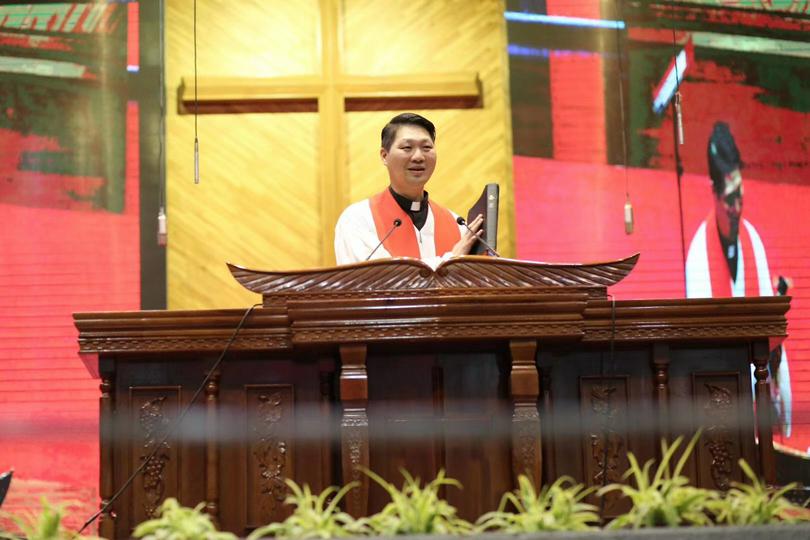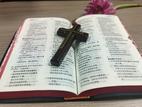This year, 2019 marks the centenary of the release of the Chinese Union Version Bible (CUV) which is most widely used and most influential Bible version in the Chinese-speaking world. Recently, the Gospel Times interviewed Lin Peiquan, an Old Testament lecturer at Jinling Union Theological Seminary and a visiting associate professor at Nankai University, to hear from him about the century-old impact of CUV and the ministry of exegesis development in China.
A Century of Impact of CUV
The translation of CUV (i.e., the official language union version) began in 1890 and ended in 1919 mostly within the three decades of the translators' team plan. The main members of the translation committee included Calvin Wilson Mateer of the American Presbyterian Church, Chauncey Goodrich of the American Congregation, and Bao Kangning, Yang Gefei, Bai Hanli from the Chinese Baptist Church as well as other Western missionaries who joined later and withdrew for different reasons (ministry busyness, retirement, and death). They were altogether sixteen leaving and staying and the selected were proficient in the original script of the Bible and the Chinese language. The Chinese Christians who assisted them in their translation were Jingyi Cheng, Wang Zhixin, Wang Xuanchen, Yu Liwen and others.
In order to avoid conflicts in the evangelization and make the Chinese Bible easily understood so as to circulate it well throughout the country, missionaries of different denominations came together and decided to translate the Bible jointly. In 1907, the New Testament translation was completed, and for the Old Testament only Psalms was translated followed by the death of Mateer. Fu Shan succeeded as chairman of the committee leading to the completion of the entire Bible, both the Old and New Testaments, which was published in 1919. Among all of the committee member,s only Fu Shan lived to the age of 82 to read the actual printed copy.
Professor Lin believes that, first of all, the CUV translation was a joint ministry of missionaries coming to China, a witness to their work in unity for the Chinese Church. The missionaries were from different countries and denominations, and although there were previously missionary conferences, it was difficult to cooperate. In 1890, it was determined that the version of the Bible to be translated was a union version, of which there were three kinds: traditional literary style (written academic literary), semi-literary style (mildly written and academic), and official language union version (spoken vernacular literary). In 1907, the semi-literary style came out and the least popular was the official language of CUV.
"Some missionaries promised to do the translation work but did not appear, and some participated but wanted to be anonymous. The participants changed constantly. Therefore, the final completion of this work is indeed a testimony of the missionaries carrying out the ministry in unity among different cultures," Professor Lin explained.
The translation of the official language version was supported by the British Bible Society, the American Bible Society and the Australian Bible Society with the greatest support from the British Bible Society.
Secondly, in the process of translating the Bible, the missionaries combined the Christian faith with Chinese culture and remain opened to their working situation. In the process of cooperation, they needed to get along with each other. Different translation skills and different denominational understandings of China lead to quarrels and arguments. For instance, the New Testament was under Mateer who was rather headstrong but he was able to put his own ideas aside when they worked together. Some quit and some continued after consideration.
"It was a lesson in unity, coordination and learning humility. Missionaries were more humble in learning Chinese culture while preaching to them," Professor Lin said.
Thirdly, from the publication of the New Testament in 1907 to the publication of the entire CUV Bible, the version had a great influence on and promoted the vernacular movement at that time. The vernacular movement was mainly in urban areas where most intellectuals educated in church schools had read the version, and its linguistic expressions and literary style had an influence on some writers of the time. In the vast rural areas, on the other hand, missionaries used vernacular language for sermons, where many believers became literate by reading the Bible. As a result, they had a better chance to pursue their faith. Literacy courses to a certain extent reduced the number of illiterates and promoted education as such in rural areas.
Fourthly, the official language CUV translation was based on the English version used at the time as its original text, which was widely accepted in the English-speaking world, being the result of the latest textual research of the English Bible. This provided a principle for Bible translations of the future--any translation or reference to a text would be based on the latest results of the Bible textual research at that time. Including the revised union version from 1984 onwards to 2004 the completion of the Revised New Testament revision, it has adopted and absorbed the results of the accepted Bible textual research.
Fifthly, from the point of view of the church, CUV promoted unity within the church. Prior to this, the Chinese Church had a variety of denominations each with a different translation, including a variety of dialect translations as well as more than 30 other translations. From the 1890s to the 1930s, many new translations were published, but they slowly were 'drowned out' as the official language CUV became accepted by all denominations of the Chinese Church.
Therefore, Professor Lin believes that after the Western missionaries left, the Chinese Church could enter the post-denominational era in the 1950s, possessing a common translated version of the Bible. Without this foundation, it may have been difficult to conduct joint worship amongst different churches. This is a wonderful testimony of the Chinese Church to the global Church.
Sixthly, the Version played an important role in the building up of the lives of Chinese believers. Professor Lin said that the inscription given to the first united Bible exhibition by the late Bishop Ding Guangxun was "The Bible Unites Us" and that all Chinese church ministry should be rooted in the Bible. Believers love the Bible because there is an authoritative translation, so many people like to recite scriptures from CUV.
Seventhly, CUV has influenced modern Chinese culture. Well-known writers, Lao She and Bing Xin were Christians. "When my father-in-law was in Beijing, he and Lao She were from the same church," Professor Lin told the interviewer. When we read literature works from the 1920s and 1930s, there are similarities with the style of CUV, similarities that can be traced to this version. In addition, this version of the Bible has many influences on the vocabulary inthe modern Chinese language. Words such as "paradise", "the forbidden fruit", "worship", "confession", "baptism", "the Gospel" "the ark", "resurrection" and "Christmas" have entered the Chinese culture due to the version.
- Translated by Charlie Li












